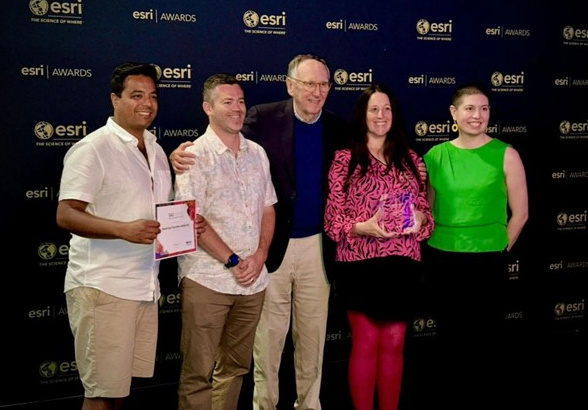When I joined the North Sea Transition Authority in 2016, my goal was to help our organisation and industry become relentlessly data driven and make huge volumes of data available to companies, empowering them to take better decisions.
In the eight years since then, the NSTA’s data and digital offering has gone from strength to strength. Yet it still came as a pleasant surprise when we won a prestigious global award for our application of digital technologies in the UK’s offshore energy system.
Despite being a relatively small UK government agency, little known outside industry circles, we became one of only three UK organisations to receive a coveted Special Achievement in GIS Award last month at the annual User Conference of software developer ESRI in San Diego, California.
The award is only presented to the best organisations globally using geographic information systems. We were among 200 global winners out of nearly 700,000 ESRI users, which put us in the top 0.03% of organisations last year.
This is a great achievement in its own right, but it’s part of a wider story, too.
We know the energy transition is a huge opportunity which can generate hundreds of billions of pounds of investment in the UK. It has the potential to be a challenging journey, however.
Clear direction, thorough planning, skilful people and technology, on top of vast amounts of investment, are just some of the things required to get us to net zero in a way which safeguards jobs and boosts the economy.
Fortunately for the UK, the North Sea gives us an upper hand over other regions, with its abundant energy production and storage resources.
"Clear direction, thorough planning, skilful people and technology, on top of vast amounts of investment, are just some of the things required to get us to net zero in a way which safeguards jobs and boosts the economy"
To realise and maximise its amazing potential, it is vital that large-scale offshore wind, carbon storage, hydrogen and oil and gas projects co-exist, along with other users of this finite marine space.
High-quality data and digital tools are key enablers of this. They help organisations to plan and make better decisions about what technologies to invest in and where to locate them.
That’s why the NSTA has devoted significant time and effort in recent years to make large volumes of valuable data available and, with the help of our partners, design game-changing apps.
We’ve got plenty to show for our efforts. Our impressive Digital Energy Platform boasts the National Data Repository, open data site, data and insights centre and Energy Portal. They have helped transform the availability of accessible data.
Through the platform, organisations can undertake spatial mapping to accommodate and integrate a range of energy production and emissions-reduction technologies offshore – and unlock the value of data.
The NDR, which migrated into the cloud in July 2021, now holds more than one petabyte of free information gleaned from more than 60 years of activity in the UKCS. Originally set up to support the oil and gas industry, it is increasingly used by companies, academics and individuals working in carbon storage, offshore wind and hydrogen.
It is making an important contribution to accelerating the energy transition. There are tangible examples – seismic processing company Rockwave used legacy oil and gas data in the NDR to help applicants make successful bids for ScotWind leases.
In addition, subsurface data in the NDR is crucial to supporting applications for carbon storage licences. On the same day that we launched the UK’s first ever carbon storage round, downloads of NDR data increased 20 times.
But it’s not just private companies who are using the data. We use it too. We apply data to continuously develop our understanding of potential carbon dioxide and hydrogen stores in support of delivering government ambitions.
High-quality datasets underpin our work to track and benchmark oil and gas operators’ efforts to reduce production emissions.
They also support our screening of opportunities to repurpose oil and gas infrastructure for the energy transition. Our analysis showed reusing pipelines for carbon dioxide and hydrogen storage could potentially saving operators around £7bn.
It’s brilliant to see this work get the recognition it deserves. As well as the ESRI award, we also bagged a brace of prizes at the Computing UK Digital Technology Leader Awards in London – among them, the gong for Best Public Sector Digital Project for the Digital Energy Platform, while colleague John Seabourn was named chief digital officer of the Year.

To win an award is a great privilege, but to lift three in just a few weeks is truly special and I am tremendously proud of our team.
But our work doesn’t stop here. It’s clear that spatial planning is crucial to achieving an integrated offshore energy sector. We will continue to seek out ways of making more data available, giving organisations the tools they need to build up a picture and visualise an exciting and vibrant future for the North Sea.
Nic Granger is director of corporate at the North Sea Transition Authority, which regulates the UK’s oil and gas, carbon storage and offshore hydrogen industries.